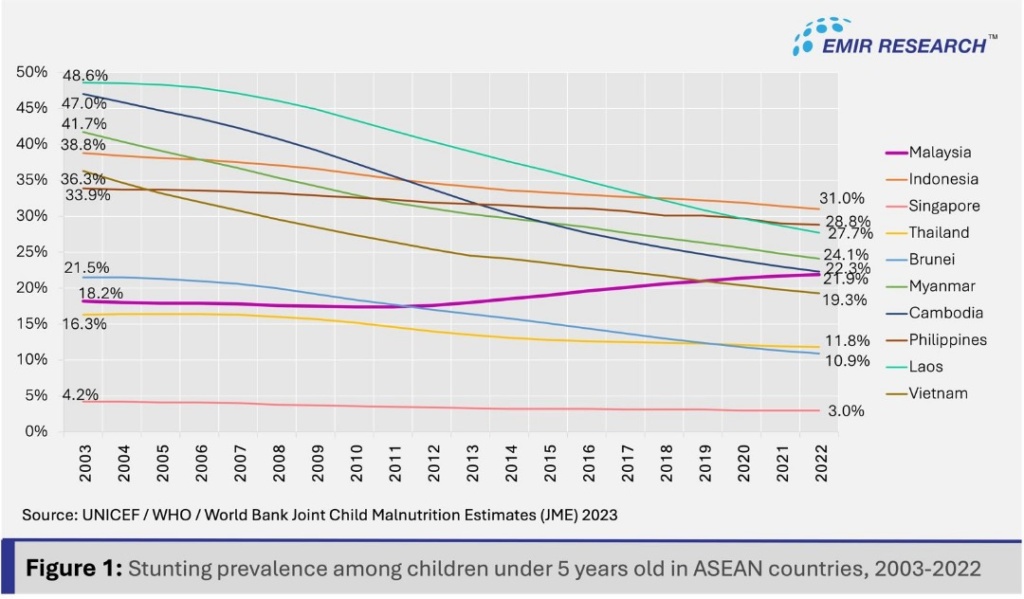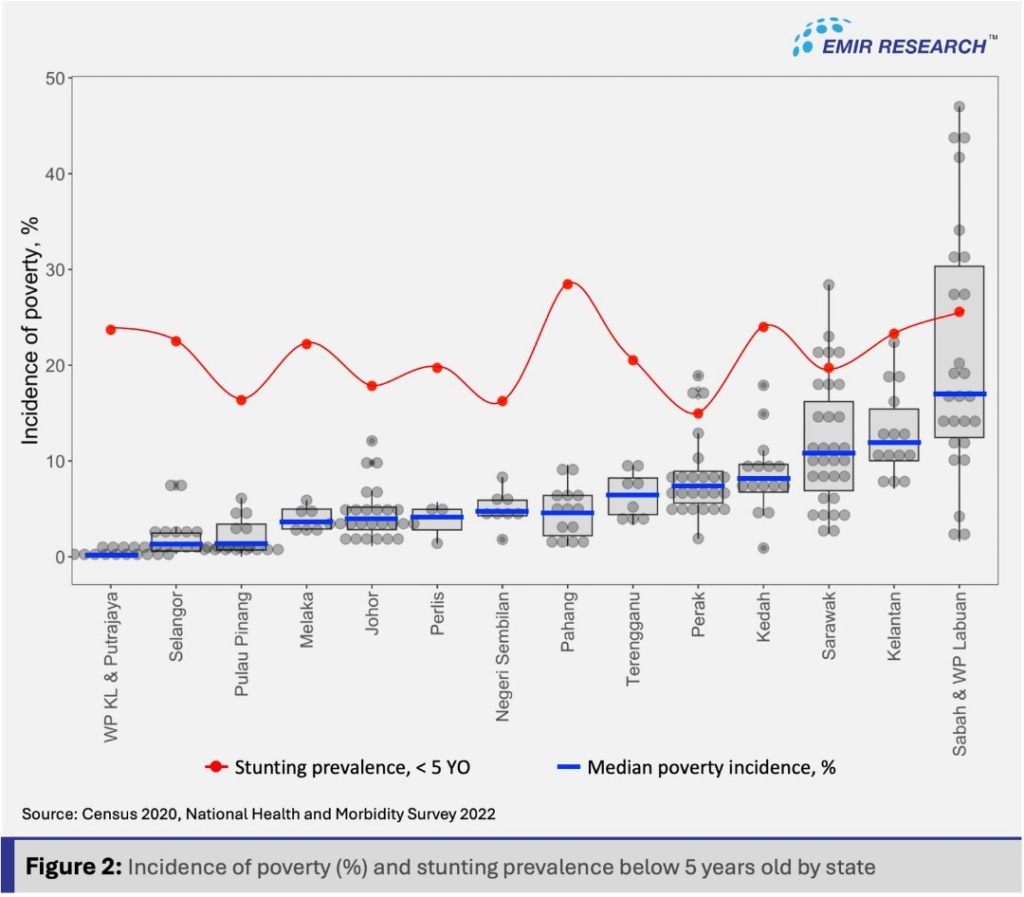
Published by TheMalaysianInsight & SinarDaily, image by SinarDaily.
In addition to its food security issues, Malaysia also finds itself amid a nutritional challenge accentuated by a high prevalence of stunting among children under 5 years old.
Defined as a shortfall in height-of-age measurement compared to the WHO Child Growth Standards median, childhood stunting has adverse effects that extend beyond the physical aspects and include cognitive, social, and economic repercussions. As a result, it presents significant obstacles to human development.
Deputy Health Minister Lukanisman Awang Sauni recently revealed that for the past five years, 29.7% of Malaysian children below 5 years old suffered from stunted growth (see “Nearly 30% of kids in M’sia have stunted growth due to unhealthy diet, says Health Ministry”, The Star, Nov 1, 2023). Furthermore, reportedly, one in five Malaysian children is stunted in growth. These figures emphasise the need to understand better the critical intersection of dietary habits and childhood development.
Unsettling numbers on stunting prevalence
According to the Joint Child Malnutrition Estimates (JME) by the World Health Organisation (WHO), United Nations International Children’s Emergency Fund (UNICEF), and World Bank, the 2022 global prevalence of stunting among children under 5 years (0-59 months) is reported at 22.3% (148.1 million).
Meanwhile, within Asia, Southeast Asia became the second-highest subregion for the stunting prevalence of children under 5, with approximately 26.4%, as noted by WHO, UNICEF, and the World Bank. Other publicly reported figures point to over half of children under 5 in Southeast Asia being affected by stunting.
An intriguing yet concerning trend emerged for Malaysia within the ASEAN region. Despite being ranked fifth in 2022 with a stunting rate of 21.9% among children below 5 years old, Malaysia stands as an outlier — over the past two decades, while other regional peers have consistently reduced their stunting prevalence, Malaysia has experienced a troubling increase, setting it apart from the positive trajectory observed in neighbouring nations (Figure 1).
In other words, Malaysia has not made any headway in meeting the target for stunting over the last 20 years, with 21.9% of children under 5 years affected — nearly equal to the average for the Asia region (21.8%), according to the 2022 Global Nutrition Report. This holds immense importance for the nation because higher stunting prevalence poses a significant risk to future generations’ long-term health and potential.
Stunted growth and child development
The primary concern with stunting is not because of its impact on the physical aspects of a child’s development. Stunting manifests as a silent crisis, negatively affecting the children’s overall development trajectory and potential.
Beyond the visible effect on height and weight, stunting encompasses a spectrum of consequences to the other more subtle physical characteristics, such as gross motor development, which, in turn, plays a pivotal role in a child’s overall physical development, coordination, and, eventually, cognitive functions.
Therefore, the real problem with stunting is its cognitive and emotional impact. Malnutrition and insufficient access to essential nutrients impede proper brain development. Moreover, children suffering from stunted growth often face social and emotional hurdles that can persist into adulthood with far-reaching economic consequences — stunted growth is empirically linked with worse economic outcomes in adulthood.
For example, a study by Grantham-McGregor et al. (2007) estimates that adults who experienced childhood stunting earn 20% less than non-stunted individuals in adulthood. Furthermore, in a meta-analytical study by Akseer et al. (2022), Malaysian stunted workers recorded the highest loss of income, approximately US$114.66 (RM539.76), compared to our regional peers.
Poverty as a catalyst
High levels of poverty are well-known to be intrinsically linked to an elevated risk of childhood stunting. In fact, given its high correlation with inadequate access to basic needs during a child’s formative years, stunting among children under 5 years old is a suitable salient indicator for assessing the degree of poverty within a population (an interesting angle to look at Figure 1 again).

Consistently, the correlation is very evident in the regions with the poorest economic opportunities. For instance, a state with the second-highest poverty rate according to the Household Income and Expenditure Surveys 2022, Kelantan (13.2%), is known for its highest proportion of stunting among children, 34% in 2016 and 23% in 2022 by the National Health and Morbidity Survey (NHMS).
However, interestingly, when examining states with varying poverty rates, like Putrajaya and WP Kuala Lumpur, a paradox emerges (Figure 2). Putrajaya and WP Kuala Lumpur, boasting the lowest poverty rate at approximately 1.5% in 2022, perplexingly record a high prevalence of stunted children alongside Kelantan, at 23.4%, according to the National Health and Morbidity Survey 2022. This underscores the need for a deeper exploration of the factors contributing to stunting beyond economic indicators.

Household food insecurity: a closer look
Household food insecurity (HFI) has been identified as another critical factor influencing child stunting, with compelling evidence from various studies. HFI is “the limited or uncertain availability or capacity to obtain and access nutritionally adequate and safe food”.
Factors contributing to HFI, such as insufficient income, lack of access to diverse and nutritious foods, and inadequate food storage and preservation methods, significantly contribute to the heightened risk of child stunting.
In a study by Singh et al. (2014), 51% of children from severely food-insecure households were stunted, compared to only 33% of children from food-secure households. Another study by Agho et al. (2019) found that children from moderate and severe food-insecure households were 2.47 and 1.82 times more likely to be severely stunted.
Zooming into the local context, a study by Naser IA et al. (2015) conducted in Kelantan discovered that out of a total of 61.4% stunted children, more than half (54.7%) were from food-insecure households — significantly higher than 6.7% of stunted children belonged to food-secure households.
Micronutrient deficiencies: hidden culprits
Within household food insecurity, micronutrient deficiencies amplify the risk of stunting. Iron, an essential micronutrient crucial for proper growth, is frequently deficient in households facing food insecurity. Inadequate iron intake hampers the body’s ability to produce haemoglobin, impacting oxygen transport and cellular development, ultimately leading to stunted growth in children.
Beyond iron, zinc deficiency may lead to deficits in children’s neuropsychologic functioning, activity, or motor development and thus interfere with cognitive performance (see “Zinc deficiency and child development”). Zinc deficiency may undermine cognitive development and affect crucial aspects such as memory, attention, and problem-solving skills, ultimately hindering a child’s overall learning potential.
Therefore, given the above factors interplay, if we wish to reverse the trend of stunting prevalence among Malaysian kids, all the relevant stakeholders need to exert a more concerted effort.
First, there is a need to tackle household food insecurity holistically through a comprehensive food security framework as suggested by EMIR Research earlier (refer to “Reinventing Malaysian Food Security Framework” in two parts). By delving into the intricacies of national food security, EMIR Research lays the foundation for an inclusive environment where every household, irrespective of socio-economic status, gains access to sufficient, affordable, safe, and, importantly, nutritious foods.
Given the prevalence of household food insecurity, focus on food security, at least in the staple food categories, can be enhanced with the food fortification approach. Fortifying staple foods, such as rice or flour, with sufficient iron, zinc, and other essential nutrients is essential, especially for households with limited access to diverse and nutritious foods.
Moreover, directing the right resources and support toward early childhood development programs is crucial to complement the effort to combat stunting. Investing in quality preschool education, sufficiently emphasising cognitive stimulation through play-based learning and age-appropriate activities, holds great potential to contribute significantly to cognitive development. This double-underscores the importance of having the highest level of professional educators — PhD level in education and their respective teaching fields — especially for the youngest students. According to EMIR Research findings, this is one of the significant trends among nations with excellent education systems (refer to “Urgent Need to Reform Malaysian Education System”).
Therefore, in the short- to medium-term, forging strategic partnerships with academic institutions, particularly dedicated research centres for child development, presents a unique opportunity to harness direly needed specialised knowledge and resources.
To conclude, the battle against childhood stunting is not merely a health crisis — it’s a race against time to secure the future of our nation. As nearly 30% of Malaysian kids suffer from stunted growth at a young age, the urgency of the situation cannot be overstated. Hence, tackling childhood stunting requires a holistic inter-ministerial effort to safeguard the well-being of our youngest generation. Our response today will determine the quality of life for generations to come.
Farah Natasya is a Research Assistant at EMIR Research, an independent think tank focused on strategic policy recommendations based on rigorous research.

